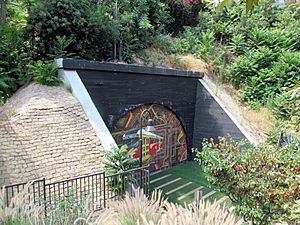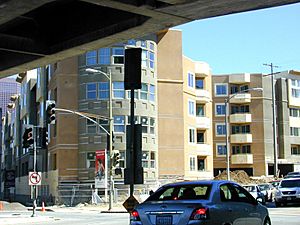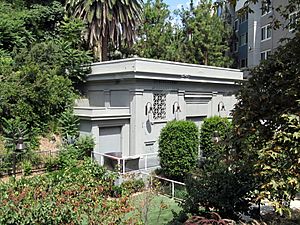Hollywood Subway facts for kids
Quick facts for kids Belmont Tunnel /Toluca Substation and Yard |
|
|---|---|

Preserved northern rail tunnel portal, 2017
|
|
| Designated | February 23, 2005 |
| Reference no. | 790 |
The Hollywood Subway, also known as the Belmont Tunnel, was a special tunnel for electric streetcars. These streetcars were called "Red Cars" and belonged to the Pacific Electric Railway. The tunnel helped these trains travel quickly across Los Angeles.
It started in the Westlake area and went all the way to the Subway Terminal Building. This building was in the Historic Core, which was a busy business area. The Subway Terminal was a major hub for the Pacific Electric trains.
Many train lines from places like the San Fernando Valley, Glendale, Santa Monica, and Hollywood used this tunnel. They entered the tunnel in Westlake and traveled under Bunker Hill to reach the Subway Terminal.
The tunnel had two tracks and was about 1.7 kilometers (1.045 miles) long. It saved trains about 8 kilometers (5 miles) of travel through busy city streets. At its busiest, 880 Red Cars used the tunnel every day. It carried over 20 million passengers each year.
The tunnel's entrance, an old electric building (substation), and the train yard are now a Los Angeles Historic-Cultural Monument. This monument is called the Belmont Tunnel / Toluca Substation and Yard. Today, the Belmont Station Apartments stand near the tunnel entrance.
Contents
History of the Hollywood Subway
Why the Subway Was Built
In the early 1900s, Los Angeles traffic was getting very bad. People needed a faster way to travel. The California Railroad Commission decided in 1922 that a subway was needed. This subway would help trains avoid the crowded downtown streets.
Plans for the "Hollywood Subway" began in 1924. Construction started in May of the same year.
Building and Opening the Tunnel
The tunnel took 18 months to build. It cost about $1.25 million, which was a lot of money back then. The Subway officially opened on December 1, 1925.
The tunnel connected trains from Beverly and Glendale Boulevards in Westlake to the new train station. This station was under the Subway Terminal Building near Pershing Square. A new power station, Toluca No. 51, was built nearby to power the trains.
The Subway helped trains reach Santa Monica, North Hollywood, and Glendale faster. It cut off about 7 miles (11 km) from journeys. This made travel much quicker than using other train lines.
The Subway's Busiest Years
The Hollywood Subway quickly became a very popular shortcut. It was faster than cars and cost only 6 cents per ride. Thousands of people used it every day in the 1920s and 1930s.
Ridership grew even more during World War II. In 1944, 880 trains used the tunnel daily. About 65,000 passengers rode through it each day. This meant over 20 million riders every year!
The End of the Red Cars
After the war, things changed. The company that owned Pacific Electric Railway sold it to a company linked to General Motors. Soon, buses started to replace the electric trains.
Pacific Electric shut down in 1955. The very last passenger train left the Belmont Tunnel on June 19, 1955. It had a sign that said, "To Oblivion." After this, the tracks were removed. The Subway Terminal Building was closed, and the Toluca Substation was turned off.
What Happened After 1955
In the 1960s, the city used the Subway for a short time to store cars. It was also used as a temporary disaster shelter. Later, parts of the tunnel were blocked by new buildings on Bunker Hill. This created two separate sections of the original tunnel.
Even after these changes, the tunnel sections were often used for filming movies and TV shows. For many years, the tunnel and substation were left alone. They became a popular spot for graffiti artists.
In 2002, the land where the substation and train yard were located was sold. A company agreed to clean and protect the old substation building and the tunnel entrance. They built the Belmont Station Apartments on the old train yard. The tunnel entrance was sealed and painted with a mural of a Red Car. The old substation building and tunnel arch are now part of a park for the apartment residents.
In 2007, the Subway Terminal Building was updated into luxury apartments. The developers made sure to restore the building's original look. The old underground station area is still there, but a wall blocks access to the tunnel.
The Tunnel in Movies and Media
The Hollywood Subway and its electric substation have appeared in many TV shows, films, and other creative works:
- The electric substation was the secret base for the Resistance in the 1980s TV show V.
- In the 1987 film The Running Man, the Belmont Tunnel was a way to escape a refugee camp.
- The substation was a gang clubhouse in the 1988 movie Colors.
- The alien's spaceship in the 1990 film Predator 2 was hidden inside the tunnel.
- In the 1992 film Reservoir Dogs, the substation was where Freddy Newandyke got ready to go undercover.
- The substation was an underground nightclub in the 2004 movie D.E.B.S..
- The album cover for Take Them On, On Your Own by Black Rebel Motorcycle Club was taken inside the tunnel.
- The music video for "Under the Bridge" by the Red Hot Chili Peppers features the substation.
- The music video for "By the Way" by the Red Hot Chili Peppers is set inside the tunnel.
- The substation appears briefly in the music video for "Get U Down Pt. 2" by Warren G.
- The tunnel and substation are in the 2005 skateboarding video game Tony Hawk's American Wasteland. Players use the tunnel to travel in the game.
- The 2011 video game L.A. Noire, set in 1947, shows the tunnel and substation as they looked when they were in use.
- The music video for "Maria Maria" by Carlos Santana is set in front of the substation.



